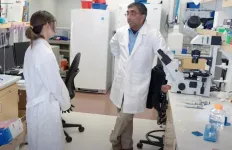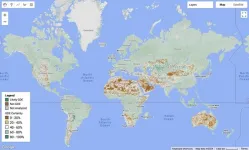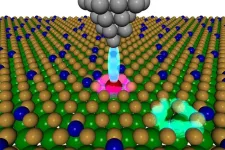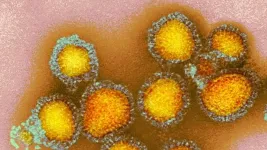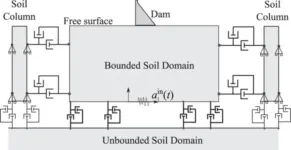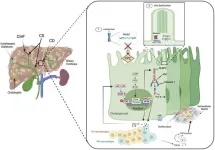(Press-News.org) Genomes can now be entrusted to store information about a variety of transient biological events inside of living cells, as they happen, like a flight recorder collecting data from an aircraft.
“Our method, which goes by the acronym ENGRAM, aims to turn cells into their own historians,” said Dr. Jay Shendure, a professor of genome sciences at the University of Washington School of Medicine and scientific director of the Brotman Baty Institute for Precision Medicine. Shendure led the effort, together with Wei Chen, a former graduate student, and Junhong Choi, a former postdoctoral fellow. Junhong Choi is now an assistant investigator at Memorial Sloan Kettering Cancer Center in New York.
ENGRAM stands for enhancer-driven genomic recording of transcriptional activity in multiplex. The acronym was inspired by a neuroscience term that refers to the physical basis for a memory.
A proof-of-concept report demonstrating some of the capabilities of ENGRAM is published today, July 17, in Nature.
“ENGRAM couples each kind of biological signal or event to a symbolic barcode. This approach offers a novel method for recording and complements previously developed molecular recording techniques.” said Wei Chen, who is now a postdoctoral fellow at the UW Medicine Institute for Protein Design.
This new strategy traces and archives the type and timing of biological signals by inserting this information into the genome. For example, this can include keeping tabs on the commands that turn genes on or off. Such recordings might hold clues to what occurs within stem cells to spur them into becoming different cell types. It might also offer insights into other questions about how cells operate, and how their past influences their future.
Shendure said that creating a biological record of cellular activities is an old idea. However, researchers had run into difficulties measuring more than a handful of signals in the same system, as well as in recording the order in which multiple signals occurred.
A few years ago, Choi, Shendure and their colleagues overcame some of these obstacles with a method called DNA Typewriter. With this system, researchers could write many symbols to DNA in an ordered fashion. However, the challenge remained of how to encode biological meaning to each symbol.
“DNA Typewriter is analogous to a keyboard with many symbols. With ENGRAM, we make those symbols specific to various biological signals of interest,” Shendure said.
In today’s Nature paper, Shendure and his team described how symbolic recording can follow the actions of non-coding DNA regions that control the protein production of neighboring genes. They also demonstrated how ENGRAM and DNA Typewriter can be combined. The scientists were able to record cell-type specific activities of dozens to hundreds of these sorts of gene-regulatory elements.
Some regions they tracked are part of gene regulatory networks behind several aspects of embryonic development. Other signals they traced mediate cell responses to stress, immune reactions to infection and cell survival.
They also applied ENGRAM to make daily recordings of mouse stem cells as they aggregated into embryonic organoids, a laboratory model of prenatal mouse development. ENGRAM might eventually help answer how, for example, a history of cell signaling events shaped the individual characteristics of a mouse embryo.
"As we were inspired by new advances in the CRISPR field for developing both the ENGRAM and DNA Typewriter systems, I imagine that these papers will inspire others to further improve genomic recording technologies – such that maybe one day we will record the entire history of cells,” said Junhong Choi.
The researchers developing ENGRAM say that work is still needed to realize what it and related genome-based recording technologies can potentially do.
“This is a strategy for capturing biological information in living systems. It is not specific to a particular field like cancer or neuroscience and hopefully will be useful across the board,” Shendure said.
Shendure noted the research covered in the paper played an important role in the development of the Seattle Hub for Synthetic Biology, a collaboration launched this past December among the Allen Institute, the Chan Zuckerberg Initiative, and the University of Washington. The project, of which Shendure serves as lead scientific director, is designing new technologies to record the history of cells over time.
The work reported today in Nature was supported by grants from the Paul G. Allen Frontiers Group, Alex’s Lemonade Stand Foundation, and the National Human Genome Research Institute (UM1HG011586, K99HG012973), as well as the Brotman Baty Institute for Precision Medicine. Shendure is an investigator of the Howard Hughes Medical Institute.
END
Genome recording makes living cells their own historians
ENGRAM chronicles signals and biological states as they occur inside cells.
2024-07-17
ELSE PRESS RELEASES FROM THIS DATE:
USC Schaeffer Institute launches new initiative to improve public policy through behavioral science
2024-07-17
The USC Schaeffer Institute for Public Policy & Government Service announced a new initiative today that leverages behavioral science to create more effective public policy.
The Behavioral Science & Policy Initiative at the USC Schaeffer Institute will conduct research to understand people’s beliefs and behaviors to create policies and communication that better fit people’s needs. The initiative will focus on policy topics such as climate change, health, and food insecurity.
“We want to help policymakers make a difference,” said Wändi Bruine de Bruin, the initiative’s ...
Groundwater is key to protecting global ecosystems
2024-07-17
(Santa Barbara, Calif.) — Where hidden water tables meet the Earth’s surface, life can thrive even in the driest locations. Offering refuge during times of drought, shallow groundwater aquifers act like water savings accounts that can support ecosystems with the moisture required to survive, even as precipitation dwindles. As climate change and human water use rapidly deplete groundwater levels around the world, scientists and policy makers need better data for where these groundwater-dependent ecosystems exist.
Now, a new study maps ...
A new approach to accelerate the discovery of quantum materials
2024-07-17
– By Michael Matz
Researchers at the Department of Energy’s Lawrence Berkeley National Laboratory (Berkeley Lab) and several collaborating institutions have successfully demonstrated an innovative approach to find breakthrough materials for quantum applications. The approach uses rapid computing methods to predict the properties of hundreds of materials, identifying short lists of the most promising ones. Then, precise fabrication methods are used to make the short-list materials and further ...
Influenza viruses can use two ways to infect cells
2024-07-17
Most influenza viruses enter human or animal cells through specific pathways on the cells’ surface. Researchers at the University of Zurich have now discovered that certain human flu viruses and avian flu viruses can also use a second entry pathway, a protein complex of the immune system, to infect cells. This ability helps the viruses infect different species – and potentially jump between animals and humans.
The majority of type A influenza viruses circulating in birds and pigs aren’t normally a health ...
Engineering resilience: Advanced FEM enhances earthquake impact assessment
2024-07-17
In a significant advancement for geotechnical engineering, a refined space-time finite element method (v-ST/FEM) has been introduced to tackle the complex dynamics of soil-structure interaction during seismic events. This new approach allows for more accurate simulations of the response of earth structures to earthquake vibrations, marking a crucial step in improving infrastructure resilience against natural disasters.
Designing structures like dams, tunnels, and embankments to withstand transient loads from sources such as earthquakes, high-speed trains, and explosions requires robust dynamic soil-structure interaction (SSI) analysis. Traditional methods often fall short in handling ...
The Vps21 signaling pathway regulates white-opaque switching and mating in Candida albicans
2024-07-17
This study was led by Dr. Guanghua Huang (School of Life Sciences, Fudan University). The team discovered that the conserved Vps21 signaling pathway plays critical roles in the regulation of white-opaque switching and mating in Candida albicans, a major human fungal pathogen.
Candida albicans is able to cause cutaneous diseases as well as life-threatening systemic infections in humans. It has multiple cellular morphologies and can undergo transitions among different morphologies to adapt to environmental changes. White-opaque transitions represent a typical morphological phenotypic switching system ...
Autoantibodies behind lifelong risk of viral infections
2024-07-17
A new study shows that about two percent of the population develop autoantibodies against type 1 interferons, mostly later in life. This makes individuals more susceptible to viral diseases like COVID-19. The study, conducted by UZH researchers together with a USZ team, is based on an analysis of a large collection of historical blood samples.
Virus infections trigger the cells of the immune system to release type 1 interferons. These proteins act as early messengers that warn uninfected cells and tissues that a virus is spreading. This allows ...
Heritable chronic cholestatic liver diseases
2024-07-17
Chronic cholestasis, defined as the impairment of bile acid formation and/or flow persisting for more than six months, encompasses a broad spectrum of hepatobiliary disorders, both heritable and acquired. This review focuses on heritable causes of chronic cholestasis, which, although less common, present significant clinical challenges. Heritable chronic cholestatic liver diseases are typically diagnosed in childhood, but many cases present and persist into adulthood. This review aims to highlight the genetics, clinical pathophysiology, presentation, ...
What fat cats on a diet may tell us about obesity in humans
2024-07-17
COLUMBUS, Ohio – Pet cats may be excellent animal models for the study of obesity origins and treatment in humans, a new study of feline gut microbes suggests – and both species would likely get healthier in the research process, scientists say.
Veterinary researchers analyzed fecal samples from fat cats as the animals lost and maintained weight over the course of four dietary changes, including strict calorie reduction. The team found that food-related changes to the cats’ gut microbiome – the assortment ...
Designing safer opioids
2024-07-17
Opioid medications offer people relief from debilitating pain, but these drugs come with dangers: the risk for addiction, miserable withdrawal symptoms and the potential for fatal overdose. In a study in ACS Central Science, researchers have identified a strategy to design safer opioids. They showed that an experimental opioid, which binds to an unconventional spot in the receptor, suppresses pain in animal models with fewer side effects — most notably those linked to fatal overdoses.
Opioid medications tap into the body’s natural system for mitigating pain by activating pain-suppressing ...
LAST 30 PRESS RELEASES:
How the parasite that ‘gave up sex’ found more hosts – and why its victory won’t last
When is it time to jump? The boiling frog problem of AI use in physics education
Twitter data reveals partisan divide in understanding why pollen season's getting worse
AI is quick but risky for updating old software
Revolutionizing biosecurity: new multi-omics framework to transform invasive species management
From ancient herb to modern medicine: new review unveils the multi-targeted healing potential of Borago officinalis
Building a global scientific community: Biological Diversity Journal announces dual recruitment of Editorial Board and Youth Editorial Board members
Microbes that break down antibiotics help protect ecosystems under drug pollution
Smart biochar that remembers pollutants offers a new way to clean water and recycle biomass
Rice genes matter more than domestication in shaping plant microbiomes
Ticking time bomb: Some farmers report as many as 70 tick encounters over a 6-month period
Turning garden and crop waste into plastics
Scientists discover ‘platypus galaxies’ in the early universe
Seeing thyroid cancer in a new light: when AI meets label-free imaging in the operating room
Neutrophil-to-lymphocyte ratio may aid risk stratification in depressive disorder
2026 Seismological Society of America Annual Meeting
AI-powered ECG analysis offers promising path for early detection of chronic obstructive pulmonary disease, says Mount Sinai researchers
GIMM uncovers flaws in lab-grown heart cells and paves the way for improved treatments
Cracking the evolutionary code of sleep
Medications could help the aging brain cope with surgery, memory impairment
Back pain linked to worse sleep years later in men over 65, according to study
CDC urges ‘shared decision-making’ on some childhood vaccines; many unclear about what that means
New research finds that an ‘equal treatment’ approach to economic opportunity advertising can backfire
Researchers create shape-shifting, self-navigating microparticles
Science army mobilizes to map US soil microbiome
Researchers develop new tools to turn grain crops into biosensors
Do supervised consumption sites bring increased crime? Study suggests that’s a myth
New mass spec innovation could transform research
Maternal nativity, race, and ethnicity and infant mortality in the US
Migration-related trauma among asylum seekers exposed to the migrant protection protocols
[Press-News.org] Genome recording makes living cells their own historiansENGRAM chronicles signals and biological states as they occur inside cells.
